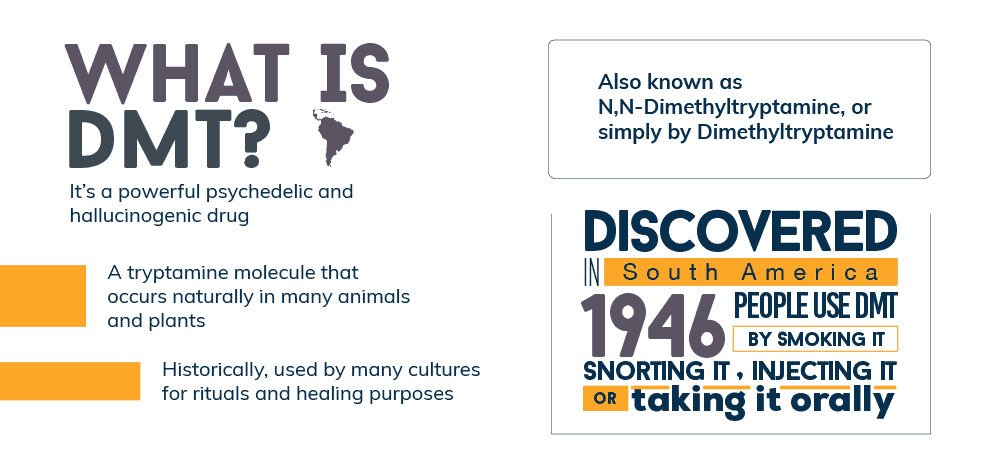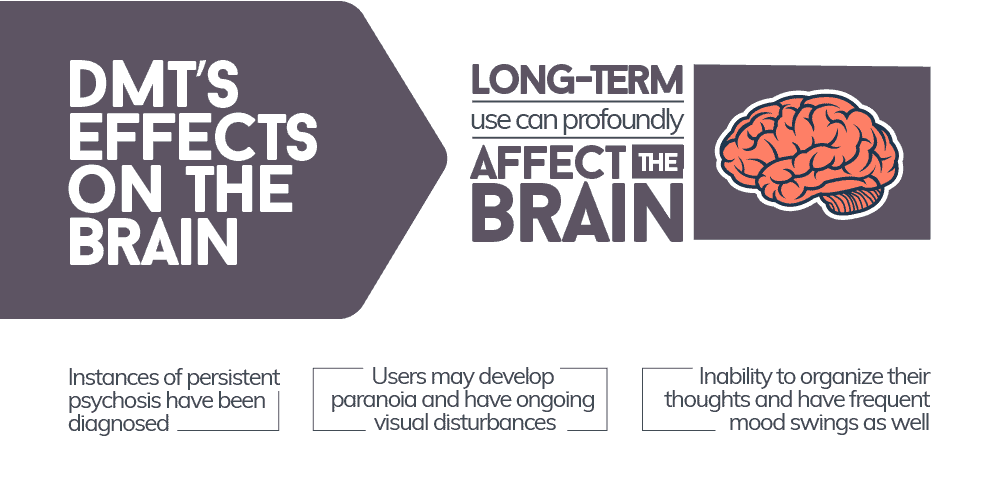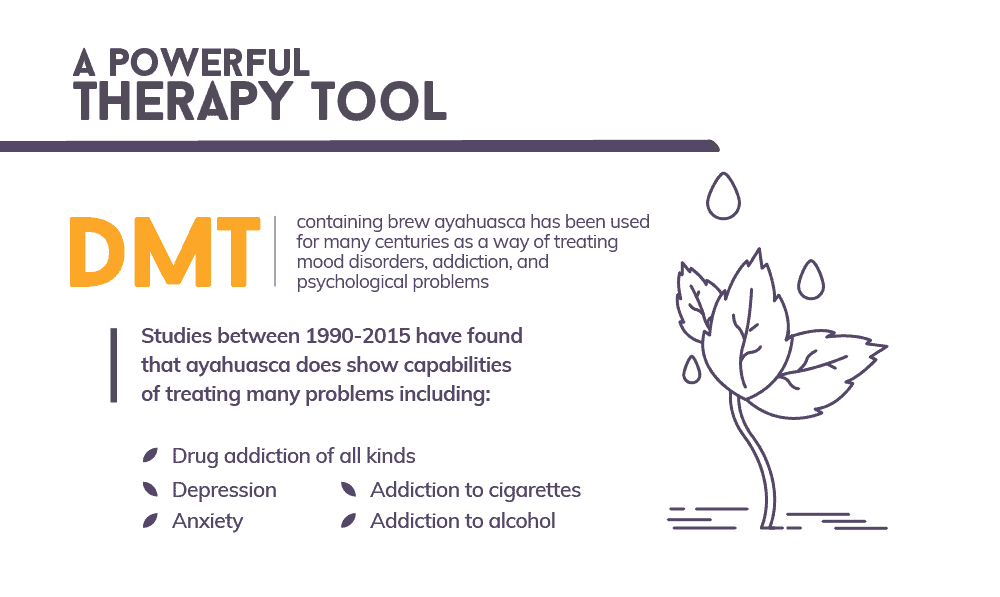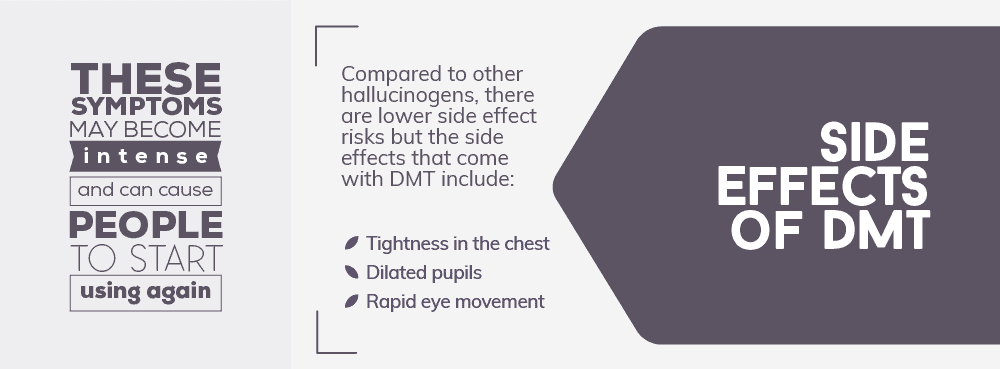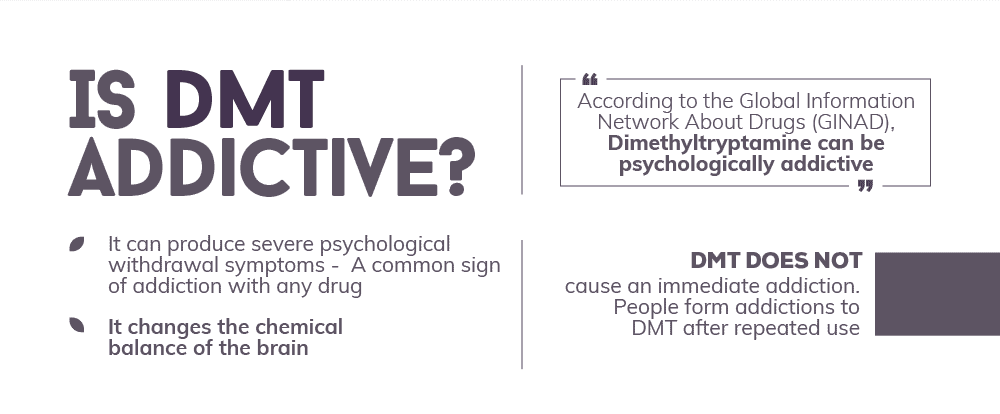DMT is a psychedelic drug. It doesn’t get the same amount of attention or publicity as other psychedelics like LSD, psilocybin, or mescaline. However, it’s still used nationwide. Moreover, the drug has powerful effects on people. We’ll help you understand what is DMT, the drug’s effects, and other key facts. Use this guide to learn more about DMT and get help for yourself or someone you care about.
What is DMT?
DMT is a powerful psychedelic drug. It comes from plants found in warm climates like Mexico, South America, and areas of Asia. The drug is increasingly popular around the world. This has lead to many people asking the question, “What is DMT?”  The full name is Dimethyltryptamine. It’s a neurotransmitter that is found in the pineal gland of mammals. It is also found in many varieties of plants. It is still not known if it’s a part of a human’s makeup in the pineal gland. Researchers have stated adamantly that they haven’t found proof of this. DMT has also been labeled the “spirit molecule.” There have been many accounts of DMT helping to induce dreams, near death experiences and visions.
The full name is Dimethyltryptamine. It’s a neurotransmitter that is found in the pineal gland of mammals. It is also found in many varieties of plants. It is still not known if it’s a part of a human’s makeup in the pineal gland. Researchers have stated adamantly that they haven’t found proof of this. DMT has also been labeled the “spirit molecule.” There have been many accounts of DMT helping to induce dreams, near death experiences and visions. 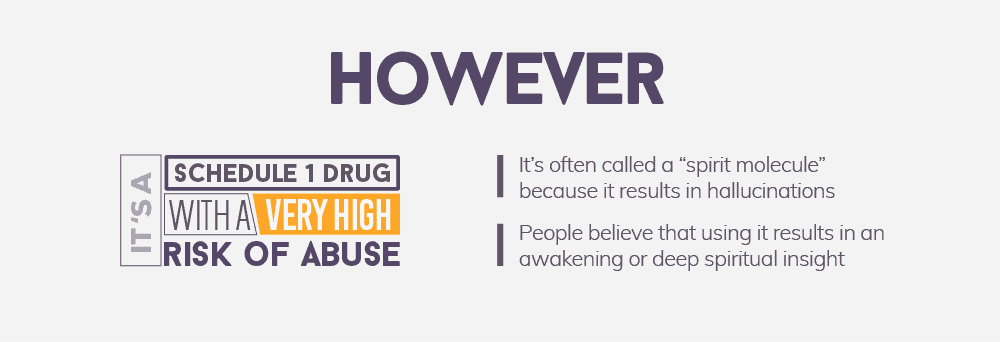 The psychedelic effects of DMT sets in quickly once you take it and the experience is short. Back in the 1960’s, it was nicknamed the businessman’s trip because it allowed people to have a psychedelic experience in less time than LSD. DMT can be inhaled, ingested, or orally taken with effects largely depending on how much you take.
The psychedelic effects of DMT sets in quickly once you take it and the experience is short. Back in the 1960’s, it was nicknamed the businessman’s trip because it allowed people to have a psychedelic experience in less time than LSD. DMT can be inhaled, ingested, or orally taken with effects largely depending on how much you take. 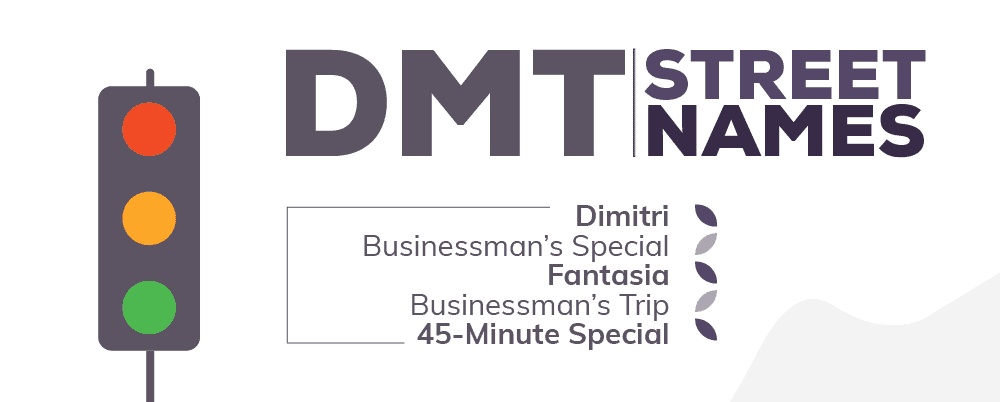 When you inhale or inject it, the effects will last for 5-15 minutes. When you’re taking it with an MAOI (such as a traditional ayahuasca brew), it can last for 3 hours or more. It is said to produce mystical experiences that seem very real. You experience euphoria and hallucinations that can connect you to higher forms of intelligence. People have reported speaking to God, elves, and aliens. The psychedelic drug is illegal in most countries because in the end, it’s a highly potent drug. DMT might be an ancient way of healing past issues but there are also downfalls.
When you inhale or inject it, the effects will last for 5-15 minutes. When you’re taking it with an MAOI (such as a traditional ayahuasca brew), it can last for 3 hours or more. It is said to produce mystical experiences that seem very real. You experience euphoria and hallucinations that can connect you to higher forms of intelligence. People have reported speaking to God, elves, and aliens. The psychedelic drug is illegal in most countries because in the end, it’s a highly potent drug. DMT might be an ancient way of healing past issues but there are also downfalls.
DMT Effects on the Brain
Like many psychedelic drugs, research on DMT is still in its early phases. The drug is a Schedule I substance by the Controlled Substances Act. As a result, it is difficult for researchers to get permission to even study it. Researchers must get permission from both the FDA and the DEA if they want to study most psychedelics. Most research on the subject is conducted in countries other than the US because of this. DMT is no different. This creates an enormous amount of paperwork and hassle. Moreover, until recently there’s been little interest in learning more about psychedelics in general and dimethyltryptamine specifically. We’ll keep this post updated and produce more content on the latest research into DMT effects, so check back frequently. The brain is a complicated organ. DMT has several effects on the brain. In fact, it is the only psychedelic we know if that is found naturally in the human body. The biggest impact occurs in the neo-cortex. This part of the brain is responsible for reasoning and decision making. It also plays a large role in memory.
“Why compromise your work and family commitments? Get the help you need from our Outpatient Treatment Program”
As a result, DMT alters the way people experience decision-making and memory. The drug connects the emotional center of the brain to the rational part. As a result, it changes the way that our emotional memory affects our decisions. Some people get tremendous value from this. Others don’t react well to their understanding of reality being shattered. DMT works like psilocybin mushrooms. It binds with serotonin receptors. As a result, neurons that normally react only when serotonin is there start firing without the chemical. This is one of the reasons that people hallucinate while on the drug. It also makes them feel like they’re visiting another reality or dimension. At the same time, they feel completely removed from normal, everyday life. 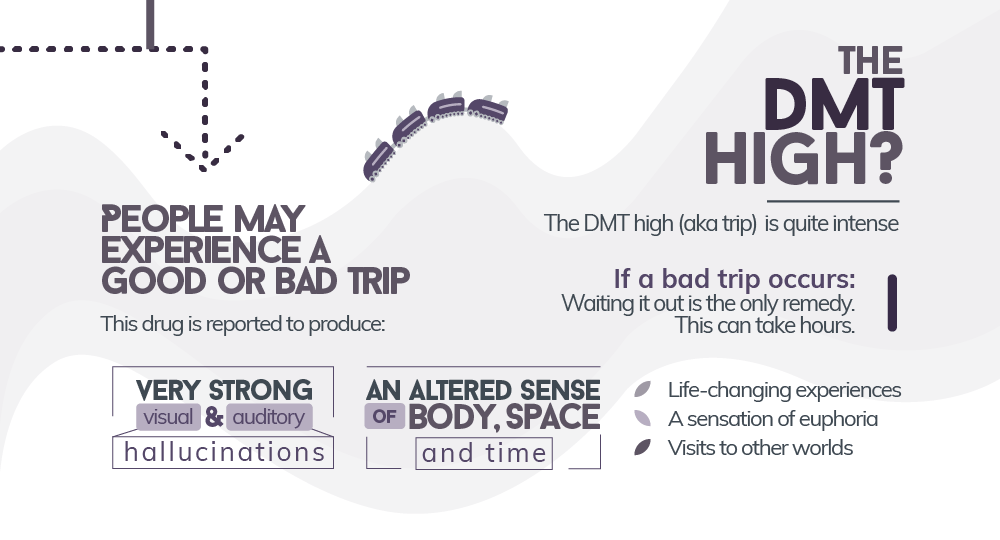 The effects of DMT on the brain are incredibly complicated. One study found that the drug affects almost 1,000 proteins in the brain. This shows how complex it is to study the drug. Each protein plays a different role in how the brain works. Many of them play multiple roles. Moreover, changes to one protein can change the way that other proteins work. The Imperial College London conducted some of the most advanced studies of DMT effects on the brain. They analyzed people on the drug through an MRI machine. They determined that it changes the way that the structures of the brain connect to each other. This makes sense given what we know about the short-term and long-term effects of DMT.
The effects of DMT on the brain are incredibly complicated. One study found that the drug affects almost 1,000 proteins in the brain. This shows how complex it is to study the drug. Each protein plays a different role in how the brain works. Many of them play multiple roles. Moreover, changes to one protein can change the way that other proteins work. The Imperial College London conducted some of the most advanced studies of DMT effects on the brain. They analyzed people on the drug through an MRI machine. They determined that it changes the way that the structures of the brain connect to each other. This makes sense given what we know about the short-term and long-term effects of DMT. 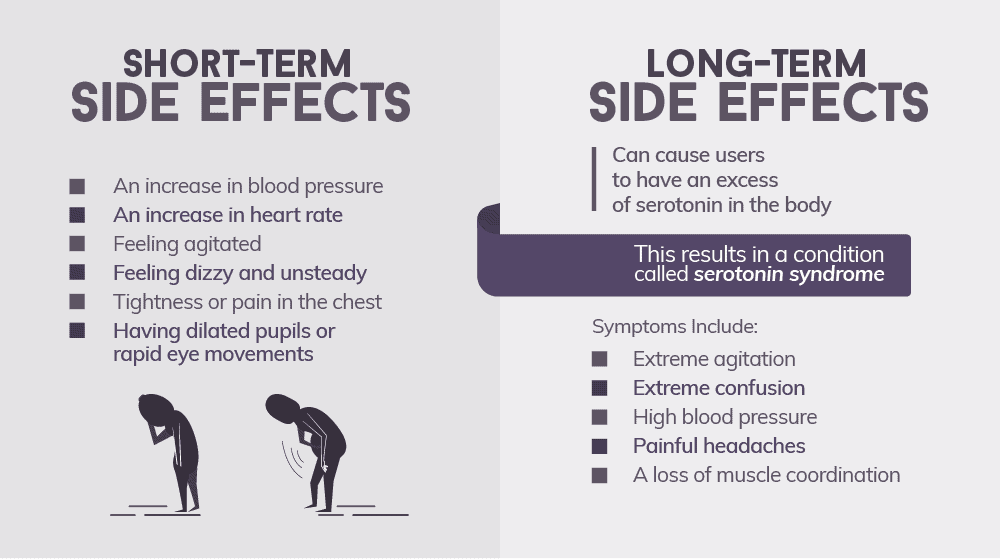
The Effects of Short-Term Use of DMT
Many people wonder, “Is DMT safe?” DMT is similar to other psychedelics in many ways. However, there’s one way where it’s very different. Most people on psychedelics know their hallucinations aren’t real. It causes incredibly realistic hallucinations. This is important to consider when looking at the long-term risks of the drug. The inability to separate hallucinations from reality can lead to dangerous and harmful psychological conditions. Another thing that sets the drug apart from other psychedelics is that it has a lower rate of people who feel the urge to use it again. As a result, more people fall into the short-term category when it comes to DMT use. Studies find that most long-term DMT users look to the drug as a crutch for other psychological issues. This stands in contrast to drugs like cocaine or heroin. People addicted to these drugs want the drug itself. Long-term DMT users want a way to escape from other issues. Some people have very pleasant hallucinations on DMT. However, some people have terrifying hallucinations. A study of 400 people in 1994 found that 25 subjects saw aliens during their experience. These people were convinced that the beings were real. They held these beliefs even after the researcher tried to convince them otherwise. The study is discussed in detail in the book DMT: The Spirit Molecule. People describe DMT-produced hallucinations as some of the most powerful. Most people who use it are already familiar with psychedelic substances. In fact, the drug is so strong that many forgo normal “drug terms” when describing it. Users refer to the experience as a journey, rather than a “trip.” The hallucinations take several forms. Some people report geometric shapes that move and vibrate. Others see beings and living things. There’s no single, universal DMT experience. The drug affects everyone in a unique way. However, no matter what form the hallucination takes, most people report similar feelings afterwards. Specially, they feel like their understanding of reality is challenged. They are more likely to question things the once accepted. This includes religious beliefs, faiths, and the nature of the universe. Nearly everyone described the experience as “mystical.” People reach different conclusions to these key questions. Some people are convinced that the “journey” they had on DMT is the actual reality. Others find a way to use the experience to reinforce their existing beliefs. The fact that DMT can alter how people understand some of their most basic beliefs in such a short time shows how powerful the drug is. This should serve as a warning to people who look to the drug as a quick or easy fix for their problems.
The Effects of Long-Term DMT Use
There haven’t been very many studies of long-term effects of DMT in people. However, there have been many studies looking at how the drug works in animals. These studies show that the drug causes damage to the parts of the brain that deal with problem solving, control mood, and cognition. DMT risks some of the same long-term effects as other hallucinogens. Two of the most common long-term effects are persistent psychosis and Hallucinogen Persisting Perception Disorder. However, more work needs to be done to understand the full balance of risks and benefits that the drug offers. Psychosis is a very broad description for several mental health issues. The best way to understand psychosis is as an impaired relationship with reality. Persistent psychosis is when a person does not or cannot correct their relationship to what is real. Persistent psychosis can take many forms. One example is auditory hallucinations. A person with persistent psychosis will continually hear noises that aren’t there. These can take the form of voices, sounds, or other things. Persistent psychosis can also show with visual hallucinations. Hallucinogen Persisting Perception Disorder (HPPD) is similar to persistent psychosis. However, it differs in a key way. A person with HPPD knows that what they are experiencing isn’t real. Some of the most common types of HPPD include seeing auras or halos around people and objects. Other people see trails from moving objects, or tracers. Additionally, most HPPD cases involve visual hallucinations, whereas persistent psychosis is just as likely to be audible as visual. In addition to these psychological issues, DMT has other long-term effects. Many people in studies said their outlook on life changed. These changes weren’t always good, and they weren’t always bad. Some people were disturbed. They felt that they could no longer trust their understanding of reality. Others felt liberated, as if they got a peak behind the curtain of the universe. They reported feeling more at ease with their lives and world in general. The fact that these changes are so powerful, along with the potential for persistent psychosis and HPPD, shows that more research needs to be done. DMT may be a powerful tool in the battle against depression, anxiety, and addiction. It may also be a ticking time bomb that will have far-reaching and harmful effects on the mental health of users.
DMT Withdrawal Effects
There’s no evidence that DMT is physically additive. However, it is psychologically addictive. That means people dependent on it won’t feel right when they don’t have access to the drug. This is similar to cravings. Users can put a lot of effort into finding their next trip. This can have harmful consequences. It’s difficult to function in daily life if your thoughts are consumed by where your next dose of DMT will come from. Moreover, people aggressively seeking the drug are more likely to take extra physical and legal risks. These include meeting with unknown drug dealers and increasing the chance you’ll be arrested. All of these are excellent reasons to seek professional addiction help if you regularly use DMT. Addiction professionals will help you understand why you feel compelled to use the drug. They can also help you cope with the psychological urge to keep using the drug. Many addiction specialists recommend therapy to help people who feel like they can’t live their lives without it. Research demonstrates that therapy is a key part to overcoming any psychological addiction, and DMT is no different.
DMT Overdose
DMT overdose information is lacking. Like other aspects of dimethyltryptamine, there isn’t a lot of research regarding overdoses. However, it is possible to overdose on the drug. One of the most influential studies in DMT research found that taking 91 times the standard dose of 60mg can cause an overdose. Some good news for DMT users is that it’s almost impossible to take that much of the drug from smoking or eating the drug. However, it could be delivered through injection. This shows how the way that you do drugs has a significant impact on the drug’s risks. Just because it’s hard to overdose on the drug doesn’t mean it isn’t dangerous. There’s a list of foods, drugs, and even seasonings that mix badly with DMT. We’ll cover this list a bit later. Moreover, DMT can bring pre-existing mental health issues to the surface. As a result, people looking for a mental health boost from the drug can find themselves in a worse position than before. Given how little research exists, there may be other risks we just don’t know about yet. Safety first is a good rule when it comes to altering your relationship to reality.
“We accept many health insurance plans. You can get your life back in order with our outpatient program today!”
DMT and Ritualistic Healing
The people in areas where DMT is indigenous will use it for healing in rituals. The neurotransmitter and tryptamine molecule in DMT contribute to expanding the mind, taking them on healing ritual trips. These are naturally occurring in many plants and it is used to gain enlightenment, healing, and ideas. It can be smoked or vaporized through a pipe, taken orally in ayahuasca teas, or snorted. The chemical root structure can be compared to anti-migraine drugs. The northwestern region of the Amazon Basin hosts the largest population of people that use DMT-containing substances for ritualistic healing. Some studies estimate that nearly 100% of the indigenous groups in Colombia, Peru, Ecuador, and Brazil use some variant of it in traditional medicine. DMT is an agonist on your serotonin receptors which has a large influence on most of your brain cells. It is believed, though not proven, that it is produced naturally in the body. The theory is that we need it as part of our makeup. They believe it could be in the pineal gland of the brain. Again, this is just theory currently and hasn’t been scientifically proven. The ritualistic aspects of the drug are leading the medical field to question how effective DMT could be for people with addiction or disorders. Letting go of past resentments, making peace, and finding new ways to cope with things are some of the benefits reported.
Is DMT a Powerful Therapy Tool?
DMT-containing brew ayahuasca has been used for many centuries as a way of treating mood disorders, addiction, and psychological problems. It is thought that ayahuasca can be part of depression, anxiety or addiction treatment. Studies between the years of 1990-2015 have found that ayahuasca does show capabilities of treating many problems. This includes:
- Depression
- Anxiety
- Addiction to cigarettes
- Addiction to alcohol
- Drug addiction of all kinds
The idea is that DMT’s therapeutic effects can help you become more mindful in your life. It has effects that are like yoga and meditation in addiction rehab. Following the use of ayahuasca, you may be less judgmental about yourself and feel a lot more centered emotionally. It has shown to help you accept yourself, which is an essential step for healing addiction and treatable mood disorders. Clinical research was being done in the 1950’s up until the 1960’s on DMT but sadly, the Controlled Substance Act of 1970 deterred further testing of hallucinogens. It became illegal and therefore unimportant as a form of medical assistance.
Who is Using DMT?
Many of the DMT advocates are those who are using it in a ritualistic way. As the high is short and the general population can choose other psychedelic drugs, it isn’t being widely abused. This may be why it isn’t causing a problem within society yet. As its origin is traced back to being used in religious practices, it is used for the same reasons in the West today. DMT is believed to give users spiritual insight which is a common positive side effect reported. The majority of new DMT users are already experienced with using psychedelic drugs, and as is the case with other illegal hallucinogens, users often obtain the drug through the Internet. DMT hasn’t been FDA approved for any type of medical use in the U.S. It has been used by researchers who require approval from the DEA and FDA. Using DMT responsibly with a shaman who helps you throughout your “awakening” or spiritual journey is advised. It is possible that an experience can pinpoint reasons for addiction and help in recovery. However, it’s important to make any decisions about addiction with a trained medical specialist. Research on DMT is sparse. Moreover, the research that does exist is still in the early phases.
Side Effects of DMT
In the U.S, DMT is a Schedule I controlled substance making it illegal. It has a high potential for abuse with no recognized use for treatment of any kind within the medical field. It lacks the safety parameters for legal drug use. There are concerning side effects of the drug, with the main effect being psychological. When taking DMT, you will experience intense visual and auditory hallucinations. You may feel as though you’re somewhere completely different. There are many accounts of out of body experiences and conversing with entities that aren’t there. Identity and reality shifts in very intense ways. Compared to other hallucinogens, there are lower side effect risks but the side effects that come with DMT include:
- An increase in heart rate and blood pressure
- Tightness in the chest
- You may become agitated
- Dilated pupils
- Rapid eye movement
- Dizziness
If you take it orally, you may experience nausea which can lead to vomiting. Some users will have an adverse reaction and become very afraid. DMT can be so powerful and real that users may have a hard time integrating their experience into their real life. The mental side effects may linger past the initial trip. This can cause a feeling of uneasiness for days or weeks after using it.
“Get the help you need today. We offer outpatient assistance, so you can maintain your work, family, and life commitments while getting the help you deserve!”
Risks of Taking DMT
One of the risks is that studies haven’t determined the toxic profile of DMT. Researchers have done studies on rodents that indicate a lethal dose is rare. You would have to take 20 times the normal dose given for ceremonial reasons to overdose. Users were asked to rate the safety. Over half stated that it was very safe. The biggest risks reported were bad trips at 51%. That is much higher than risks of bad experiences reported by those who have tried LSD. DMT may cause serotonin syndrome which can be a deadly health risk. It can occur when the body has too much serotonin build up. It is caused when you take different drugs with DMT. For those who take antidepressants, it is highly advised you don’t try DMT. Serotonin syndrome can cause the following symptoms:
- Confusion
- Agitation
- High blood pressure
- A loss of coordination
- Headaches
- Hallucinations and visual disturbances.
Substances You Shouldn’t Mix with DMT
As DMT already affects your serotonin levels, it shouldn’t be taken alongside any of the following substances.
- Prozac or drugs that are selective serotonin reuptake inhibitors (SSRI’s)
- High blood pressure medications
- Diet pills
- Antihistamines
- Medicine for asthma treatment
- Drugs containing the following: dextromethorphan/ DXM or with DM, DX or Tuss
- Drugs like Xanax and Ativan that are depressants for the central nervous system
- Alcohol
- Barbiturates
- Cocaine
- Amphetamines
- Opiate drugs
- Nutmeg
As not enough research has been done, it’s hard to know what the long-term effects could be when using DMT. So far, research hasn’t found that it creates tolerance in users. The greatest risks so far are psychological. A mental health issue that may occur is called hallucinogen persisting perception disorder (HPPD). For those who frequently use DMT, it can lead to psychosis. Symptoms like disorganized thought, paranoia, and visuals that don’t match up to the present. Symptoms that occur in HPPD can create neurological issues like brain tumors or strokes.
DMT Addiction and Abuse
DMT has not been proven to be addictive by nature but some may abuse it. When someone combines it with other psychoactive substances, problems can occur. Mixing drugs can cause negative hallucinogen problems which can be highly stressful on a “trip”. There have been reports of people taking more than intended, or not being able to stop DMT use. It’s a similar kind of affliction to chronically using marijuana. While the drug itself isn’t addictive, you may find yourself unable to stop using DMT because you become dependent on the feeling. When DMT is used for ritualistic reasons with proper guidance, it has shown to be an effective way to cope with past traumas. This may be key to helping people with personality disorders and addiction. It’s when you overuse it or mix it with other drugs that it can become hazardous. While illegal, there are many advocates within the medical field that suggest DMT can be highly useful for certain patients. Much more research needs to be done of course but, in the meantime, it seems to be an isolated group of people that choose DMT. 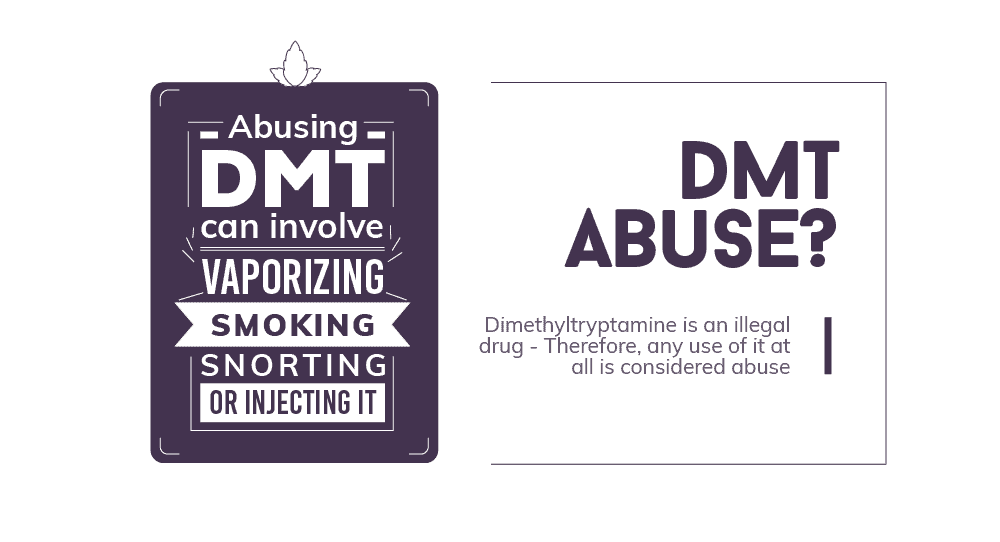
DMT Drug Rehab
DMT rehab is an important part of living a clean life. The drug may not be physically addictive, but psychological addictions can be even harder to break. Getting help can make the road to recovery easier. Psychotherapy is one popular tool for breaking addictions. Many people with psychological addictions use drugs as a way to cope with another condition. Therapy helps people understand the reasons they turned to drugs. It helps them deal with those issues. This helps them stop focusing on drugs and start making real progress toward living a better life. Some people see DMT as a way to break other addictions. However, the science is far from complete on this point. It’s vital to avoid self-diagnosis and self-medicating when it comes to treating addiction. Creating treatments for yourself can be dangerous. This is especially true when it comes to using powerful and poorly understood drugs.
What Did you Think About This Blog?
Give it a Rating!
Full Infographic:
 NCBI, Frontiers in Pharmacology (2016) The Therapeutic Potentials of Ayahuasca: Possible Effects against Various Diseases of Civilization. Retrieved from, https://www.ncbi.nlm.nih.gov/pmc/articles/PMC4773875/ NCBI, Mens Sana Monographs (Jan, 2008) Neurobiology of Spirituality. Retrieved from, https://www.ncbi.nlm.nih.gov/pmc/articles/PMC3190564/ NCBI, Ther Adv Psychopharmacol (june, 2016) Antidepressive, anxiolytic, and antiaddictive effects of ayahuasca, psilocybin and lysergic acid diethylamide (LSD): a systematic review of clinical trials published in the last 25 years. Retrieved from, https://www.ncbi.nlm.nih.gov/pmc/articles/PMC4910400/ NCBI, J Psychopharmacol (june, 2013) Harms and benefits associated with psychoactive drugs: findings of an international survey of active drug users. Retrieved from, https://www.ncbi.nlm.nih.gov/pmc/articles/PMC4107777/
NCBI, Frontiers in Pharmacology (2016) The Therapeutic Potentials of Ayahuasca: Possible Effects against Various Diseases of Civilization. Retrieved from, https://www.ncbi.nlm.nih.gov/pmc/articles/PMC4773875/ NCBI, Mens Sana Monographs (Jan, 2008) Neurobiology of Spirituality. Retrieved from, https://www.ncbi.nlm.nih.gov/pmc/articles/PMC3190564/ NCBI, Ther Adv Psychopharmacol (june, 2016) Antidepressive, anxiolytic, and antiaddictive effects of ayahuasca, psilocybin and lysergic acid diethylamide (LSD): a systematic review of clinical trials published in the last 25 years. Retrieved from, https://www.ncbi.nlm.nih.gov/pmc/articles/PMC4910400/ NCBI, J Psychopharmacol (june, 2013) Harms and benefits associated with psychoactive drugs: findings of an international survey of active drug users. Retrieved from, https://www.ncbi.nlm.nih.gov/pmc/articles/PMC4107777/

